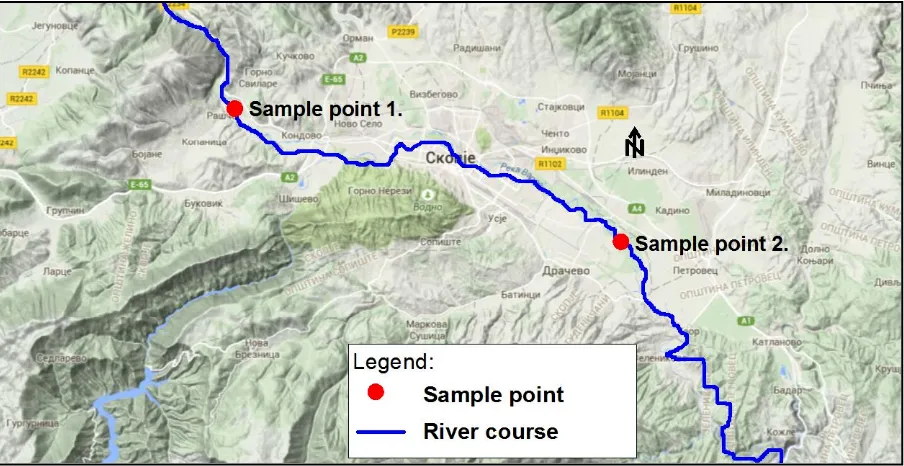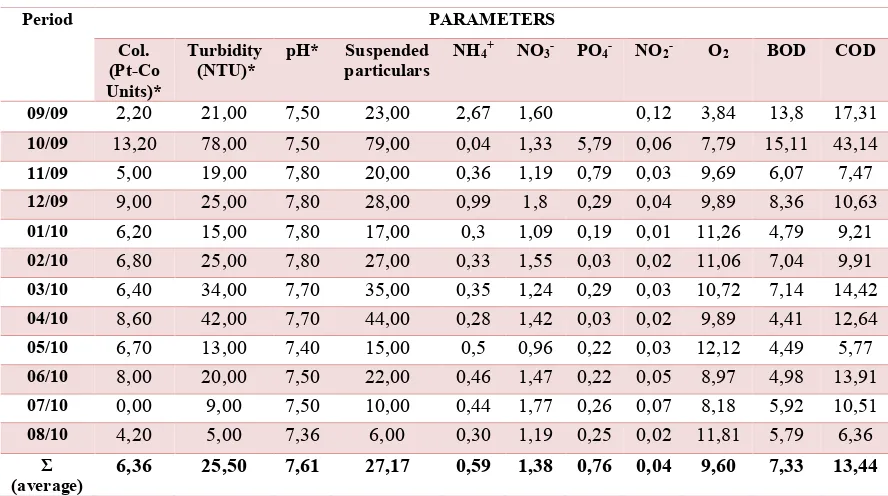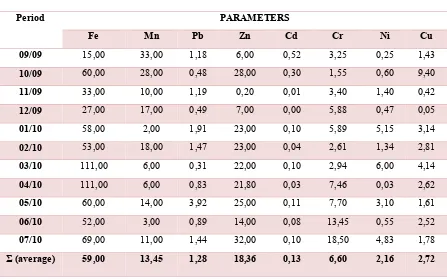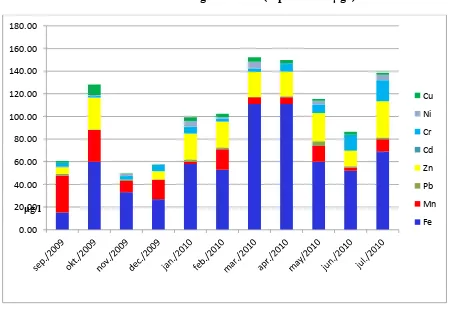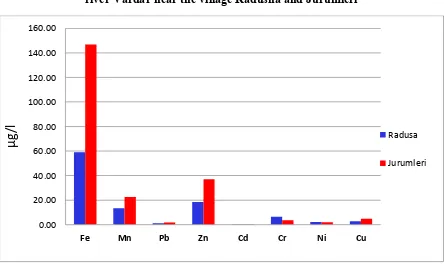www.ijaer.in Copyright © IJAER 2016, All right reserved Page 1057
ASSESSMENT OF THE WATER QUALITY OF THE RIVER VARDAR
IN TERMS OF THE IRRIGATION IN SKOPJE VALLEY IN THE
REPUBLIC OF MACEDONIA
1 Bojkovska R., 2 Pavlov K., 3 Pavlovski G.
1National Hydrometeorological Service, Skopje, Republic of Macedonia
2Josip Broz-Tito High School, Skopje, Republic of Macedonia, kolepavlov@yahoo.com
3University of "Goce Delcev" in Stip, Republic of Macedonia
ABSTRACT
Skopje Valley is the second largest and also the most populous region in the country. Waste water from households, industry and agriculture ends up in the Vardar River as the largest drainage artery in the region in the republic. Due to the international conventions for the protection of international watercourses and therefore benefiting from irrigation water, the quality of Vardar River in Skopje and elsewhere in R. Macedonia is permanently active topic under constant surveillance. The waters of Vardar through the Skopje string section according to the legal regulations of the Republic Macedonia, shows solid summative quality. More worrisome is the situation with the organic loads and heavy metals that reduce the irrigation eligibility for agricultural purposes.
Keywords: Skopje Valley, Vardar, Measuring Point, Pollution, Heavy Metals, etc.
INTRODUCTION
www.ijaer.in Copyright © IJAER 2016, All right reserved Page 1058
(point 1, fig. 1) and the area near to Jurumleri (point 2, fig. 1). The assessment of the water quality of Vardar was based on 11 parameters of the basic physical and chemical analysis and 8 heavy metals as a criterion for quality that have a significant impact on agricultural production, during the irrigation conditions. The purpose of the paper is to systematically detect the actual quality, contamination and spatial distribution of heavy metals in the water flow and to identify natural and anthropogenic sources of pollution in order to propose the most appropriate measures to prevent pollution and improving water quality.
STUDY AREA
Skopje Valley is situated in the northern part of the Republic Macedonia. It occupies the upper basin of the Vardar Riverand the territory bounded by mountains: Goleshnica, Karadjica, Suva Montain, Suva Gora, Zeden, Skopska Crna Gora and the Gradishtanska Mountain [3]. Skopje Valley covers the lower catchment areas of some of the major tributaries (Treska, Lepenec, Pchinja) and also the catchment areas of some of the smaller tributaries like (Serrava, Markova River). In this framework the Skopje Valley covers 1924.2 km2 or 7.5 % of the territory of the Republic Macedonia and in the flat strip to 300 meters above sea level are accounted 343.9 km2 (fig. 1).
Figure 1. Vardar River through the Skopje Valley
METHODS AND MATERIALS
www.ijaer.in Copyright © IJAER 2016, All right reserved Page 1059
the measurement points was dedicated executively, starting from the practical agricultural purposes. The first, upper monitoring point downstream from the village Radusha was determined in order to assess which input in Skopje Valley is entered from the upstream of the Polog region, and the lower monitoring point near the village Jurumleri is chosen in order to assess what changes undergone in the waters of Vardar in the Skopje region and its suitability for irrigation. Sampling was carried out at the measurement point nearby villages of Raduša and Jurumleri with a monthly frequency measuring for physical-chemical parameters of water. The Sampling was implemented according to the ISO 5667. Water samples were collected in polyethylene bottles previously washed with hydrochloric acid and rinsed out with abundant-distilled water in the laboratory and with abundant river water before collection. On the field are measured temperature, pH, conductivity, dissolved oxigen (DO), saturation with WTW Multi 340I set, alkalinity is determined by titration, oxygen fixation was made immediately and measured by Winkler method, biochemical oxygen demand (BOD5)and chemical oxygen demand (COD) by KMnO4. Other parameters were analyzed in the laboratory of the hydrometeorological service. Hardness by EDTA titration, nutrients is determined by spectrophotometry using UV-VIS Varian Carry 100. Sulfate, chloride, Ca, and Mg by titration. Heavy metals concentration of: Fe, Mn, Pb, Cd, Zn, Cr, Ni, and Cu are determined by atomic absorption spectrometry using Varian 220 by graphite furnace and flame technique. As methods for determination of these parameters were used methods recommended by Standard Methods for the Examination of Water and Wastewater APHA, EPA, and EN/ISO methods. Water quality assessment was based on Macedonian regulation for classification of water quality. According to the Macedonian regulation [10] water was classified in five classes, from very good (class 1) to very bad (class 5).
RESULTS AND DISCUSSION
In the group of indicators of the basic physical and chemical analysis were taken into account 11 parameters of the two measuring points such as: color (Pt-Co Units), turbidity (NTU), pH, suspended particulars, ammonia (NH4 +), nitrates (NO3-), phosphates (PO4-), nitrites (NO2-), dissolved oxygen, biochemical oxygen demand (BOD) and chemical oxygen demand (COD) from KMnO4.
Table 1. Physico-chemical analysis of Vardar River near the village Radusha expressed in mg/l, except (*)
Period PARAMETERS
Col. (Pt-Co Units)*
Turbidity (NTU)*
pH* Suspended particulars
NH4+ NO3- PO4- NO2- O2 BOD COD
09/09 8,80 16,00 7,97 18,00 0,13 1,18 0,93 0,08 9,89 3,24 8,02
10/09 6,30 56,00 7,87 58,00 0,02 1,76 0,17 0,05 10,31 4,70 22,76
11/09 3,70 20,00 7,74 21,00 0,12 1,23 0,13 0,03 10,46 2,38 6,16
12/09 4,10 9,00 7,73 11,00 0,11 1,33 0,10 0,02 11,27 2,76 6,72
01/10 5,30 12,00 7,68 13,00 0,07 1,09 0,07 0,01 11,34 0,97 8,65
www.ijaer.in Copyright © IJAER 2016, All right reserved Page 1060
03/10 6,70 50,00 7,79 33,00 0,08 1,28 0,20 0,11 10,93 4,14 6,72
04/10 6,50 22,00 7,73 23,00 0,07 0,81 0,07 0,01 10,76 2,17 8,53
05/10 7,30 30,00 7,73 31,00 0,09 1,05 0,05 0,01 13,79 5,38 7,35
06/10 4,70 17,00 7,69 18,00 0,04 1,31 0,07 0,02 9,73 2,20 12,33
07/10 5,70 21,00 7,74 22,00 0,11 1,31 0,22 0,05 9,38 2,75 9,48
08/10 3,8 17 7,78 19 0,08 3,05 0,12 0,04 9,6 2,11 6,28
Σ (average)
5,66 24,00 7,76 23,83 0,08 1,41 0,18 0,04 10,75 2,89 9,30
Table 2. Physico-chemical analysis of Vardar River near the village Jurumleri expressed in mg/l, except (*)
Period PARAMETERS
Col. (Pt-Co Units)*
Turbidity
(NTU)* pH* particulars Suspended NH4 + NO
3- PO4- NO2- O2 BOD COD
09/09 2,20 21,00 7,50 23,00 2,67 1,60 0,12 3,84 13,8 17,31 10/09 13,20 78,00 7,50 79,00 0,04 1,33 5,79 0,06 7,79 15,11 43,14 11/09 5,00 19,00 7,80 20,00 0,36 1,19 0,79 0,03 9,69 6,07 7,47 12/09 9,00 25,00 7,80 28,00 0,99 1,8 0,29 0,04 9,89 8,36 10,63 01/10 6,20 15,00 7,80 17,00 0,3 1,09 0,19 0,01 11,26 4,79 9,21 02/10 6,80 25,00 7,80 27,00 0,33 1,55 0,03 0,02 11,06 7,04 9,91 03/10 6,40 34,00 7,70 35,00 0,35 1,24 0,29 0,03 10,72 7,14 14,42 04/10 8,60 42,00 7,70 44,00 0,28 1,42 0,03 0,02 9,89 4,41 12,64 05/10 6,70 13,00 7,40 15,00 0,5 0,96 0,22 0,03 12,12 4,49 5,77 06/10 8,00 20,00 7,50 22,00 0,46 1,47 0,22 0,05 8,97 4,98 13,91 07/10 0,00 9,00 7,50 10,00 0,44 1,77 0,26 0,07 8,18 5,92 10,51 08/10 4,20 5,00 7,36 6,00 0,30 1,19 0,25 0,02 11,81 5,79 6,36
Σ
(average) 6,36 25,50 7,61 27,17 0,59 1,38 0,76 0,04 9,60 7,33 13,44
The color as an indicator of the two measuring points in the river Vardar in the investigated period shows constant values of quality Class I, and apparently in the lower measuring point at the village Jurumleri there is minimal deterioration in terms of annual averages (tab. 1, 2).
Turbidity as a form of mechanical water pollution directly affects the dispersion of light, oxygen saturation, photosynthesis and photolysis [7]. Samples of the two measuring points demonstrate permanent turbidity of the water of the river Vardar throughout the year with values appropriate of quality class V. The poor quality of water present in the upper measuring point at the village Radusha (24.0) is further exacerbated at the lowest point (25,5), in. Jurumleri (tab. 1, 2).
www.ijaer.in Copyright © IJAER 2016, All right reserved Page 1061
or the increased acidity causes the dissolution of toxic metals and is a fatal threat to the organic world [6].
Suspended solids, as an indication of mineralization, are usually the result of natural erosion processes. In terms of this indicator we see that the river Vardar in Skopje Valley enters with quality class II near the village Radusha averaging 23, 83 mg/l and the same quality class retains the lower measuring point at the village Jurumleri with a slight increase in the concentration of an above 27,12 mg/l (tab. 1, 2).
From the forms of nitrogen as a nutrient, ammonium ion (NH4+) is toxic and unstable form which elevated concentrations reflect the burden of aquatic ecosystems waters, especially if the amount of dissolved oxygen is low. At the measuring point in the village Radusha that refers to concentrations of quality class I-II (average 0, 08 mg/l), and the impact of the sewage from the city of Skopje and other villages on the waters of Vardar is visible on the lower measuring point at the village Jurumleri, where the concentrations of ammonium ion increased to seven times than the average 0, 59 mg/l (tab. 1, 2). The input of nitrates (NO3-) as a form of nitrogen in the river water goes through disposal of animal waste, feces and washing of soil treated with fertilizers [12]. The concentration of nitrates in the Vardar River in Skopje Valley through the examined period is held within quality class I-II (tab. 1, 2). Here we record and some decrease from the top (1,41 mg/l) to the lowest measuring point (1,38 mg/l). Nitrite (NO2) is an intermediate product between ammonia and nitrates. Nitrite is a toxic form of nitrogen for the wildlife in waters but in very low concentrations. In the waters of Vardar in Skopje Valley at the two measuring points were recorded annual concentrations of 0,04 mg/l, corresponding quality class III-IV and undoubtedly includes anthropogenic factor for their input through wastewater, agricultural and industrial activities.
Phosphorus as a nutrient was tested through orthophosphate ion (PO4-). It comes from the minerals of the lithosphere and the fertilizers. It is non-toxic to living organisms in the water so that it in the legal norms of the Republic of Macedonia there are no prescribed limits. However, its annual monitoring in the waters of Vardar and obvious increase from the measuring point in Radusha (0,18 mg/l) to that of Jurumleri (0,76 mg/l) shows that the treatment in this area with fertilizers in agricultural activities is accurate.
www.ijaer.in Copyright © IJAER 2016, All right reserved Page 1062
dissolved oxygen. The measuring point in Radusha (point 1) indicates an average annual quality class II (2,89 mg/l), while at the lower measuring point in Jurumleri (point 2) the quality drops to class IV (7,33 mg/l). Chemical oxygen demand (COD) by KMnO4 is an indicator that reflects oxygen consumption for total decomposition and oxidation process of the present metals in the water. Deterioration in the quality of Skopje section is obvious (tab. 1, 2), and also the involvement of anthropogenic factor, so that in the upper control point shows average quality of class II (9, 30 mg/l), and at the lower point shows quality of class IV (13, 44 mg/l). Seasonal, the situation is most critical during the summer months due to reduced water levels and the increased concentration of organic materials and metals.
Regarding the burden of the Vardar River water with heavy metals, reviewed were: iron, manganese, lead, zinc, chromium, nickel, and copper (tab. 3, 4). These substances are considered toxic in relatively low concentrations to plant and animal life and tend to accumulate in the food chain.
Table 3. Concentrations of heavy metals in the water of Vardar River near the village Radusha (expressed in μg/l)
Period PARAMETERS
Fe Mn Pb Zn Cd Cr Ni Cu
09/09 15,00 33,00 1,18 6,00 0,52 3,25 0,25 1,43
10/09 60,00 28,00 0,48 28,00 0,30 1,55 0,60 9,40
11/09 33,00 10,00 1,19 0,20 0,01 3,40 1,40 0,42
12/09 27,00 17,00 0,49 7,00 0,00 5,88 0,47 0,05
01/10 58,00 2,00 1,91 23,00 0,10 5,89 5,15 3,14
02/10 53,00 18,00 1,47 23,00 0,04 2,61 1,34 2,81
03/10 111,00 6,00 0,31 22,00 0,10 2,94 6,00 4,14
04/10 111,00 6,00 0,83 21,80 0,03 7,46 0,03 2,62
05/10 60,00 14,00 3,92 25,00 0,11 7,70 3,10 1,61
06/10 52,00 3,00 0,89 14,00 0,08 13,45 0,55 2,52
07/10 69,00 11,00 1,44 32,00 0,10 18,50 4,83 1,78
www.ijaer.in Copyright © IJAER 2016, All right reserved Page 1063
Table 4. Concentrations of heavy metals in the water of the river Vardar near the village Jurumleri (expressed in μg/l)
Period PARAMETERS
Fe Mn Pb Zn Cd Cr Ni Cu
09/09 21,00 46,00 2,85 6,00 0,23 0,07 1,91 1,50
10/09 226,00 66,00 0,72 52,00 0,72 1,64 4,19 21,84
11/09 73,00 2,00 2,53 13,60 0,10 1,39 0,52 1,86
12/09 69,00 29,00 2,76 51,00 0,05 9,60 0,93 0,14
01/10 529,00 9,00 1,33 46,00 0,07 2,46 4,36 3,70
02/10 167,00 15,00 1,66 0,06 0,09 2,19 0,51 5,61
03/10 95,00 19,00 0,74 44,00 0,09 1,92 1,85 4,29
04/10 95,00 19,00 3,25 43,70 0,13 2,86 1,96 6,31
05/10 169,00 1,00 1,33 35,00 0,14 2,11 0,28 3,45
06/10 133,00 2,00 0,25 55,00 0,04 5,80 1,20 2,78
07/10 40,00 40,00 2,51 61,00 0,06 9,58 4,99 0,56
Σ (average) 147,00 22,55 1,81 37,03 0,16 3,60 2,06 4,73
Figure 2. Annual regime of the concentration of heavy metals in the water of the river Vardar near the village Radusha (expressed in μg/l)
0.00 20.00 40.00 60.00 80.00 100.00 120.00 140.00 160.00 180.00
μg/l
Cu
Ni
Cr
Cd
Zn
Pb
Mn
www.ijaer.in Copyright © IJAER 2016, All right reserved Page 1064
Figure 3. Annual regime of the concentration of heavy metals in the water of the river
Vardar near the village Jurumleri (expressed in μg/l)
Figure 4. Average annual values of concentration of heavy metals in the water of the river Vardar near the village Radusha and Jurumleri
0.00 100.00 200.00 300.00 400.00 500.00 600.00 700.00
μg/l
Cu
Ni
Cr
Cd
Zn
Pb
Mn
Fe
0.00 20.00 40.00 60.00 80.00 100.00 120.00 140.00 160.00
Fe Mn Pb Zn Cd Cr Ni Cu
μ
g
/l
Radusawww.ijaer.in Copyright © IJAER 2016, All right reserved Page 1065
Iron is one of the most widespread metals in the lithosphere and surface waters. The increased concentration of iron in the water is distracting the osmo regulation of the plant, and thus the quality of agricultural food. In irrigation water it is not recommended to be with concentrations above 5 μg/l [4]. In the waters of river Vardar in Skopje Valley in the upper measuring point the average year concentrations correspond to quality of Class I (59,0 μg/l) and in the lower measuring point with the same quality but with elevated values of 147, 0 μg/l (tab. 3, 4; fig. 2, 3, 4). Dangerous concentrations of iron were detected only in January in Jurumleri (point 2, fig. 1) with 529 μg/l, referring to quality of Class III-IV, which reflect the tested anthropogenic influence of the section between the two measuring points.
Manganese in water is naturally derived mostly from dissolution of shales and sandstones, and throws the man through metallurgical activities. That reduces photosynthesis in plants by reducing the absorption of sunlight. In irrigation water it must not exceed a concentration of 0,2 μg/l [4]. At the two measuring points in Skopje Valley in the water of the Vardar River that concentration has dramatically exceeded, but under national rules of classification still remains within the class I. The increase in concentration occurs downstream from 13, 45 μg/l to 22, 55 μg/l (tab. 3, 4; fig. 2, 3, 4).
Lead is a heavy metal which in the rivers can be deposited by mining and industrial waste from factories, military assets, batteries, etc [7]. Irrigation water in its concentration, in a long-term, should not exceed 5,0 μg/l [5]. Lead as a toxic metal is accumulated in the roots of plants. The clearness of the river water through Vardar Skopje Valley for agricultural needs is quite high from the average values examined period at the two measuring points (1,28 μg/l and 1,81 μg/l) which constantly keeps the water quality within the class I-II (tab. 3, 4; fig. 2, 3, 4).
Zinc is an essential element for plants and animals as it is necessary for the functioning of certain enzymes. Zinc is relatively non-toxic to terrestrial organisms. It is acutely and chronically toxic to aquatic organisms, particularly fish. Zinc toxicity decreases with increasing hardness, increases with increasing temperature, and increases with decreasing dissolved oxygen [6]. If it is known that in unpolluted water its concentration does not exceed 5 μg/l, then the visible impact of anthropogenic factor on the waters of Vardar River in Skopje Valley where even within the class I-II, water quality downstream deteriorate at an average from 18,36 μg/l (Radusa) to 37,03 μg/l (Jurumleri).
www.ijaer.in Copyright © IJAER 2016, All right reserved Page 1066
slightly exceeded the maximum permissible limits and reports values of quality class III-IV (tab. 3, 4; fig. 2, 3, 4). The slight increase in its concentration of 0,13 μg/l (Radusa) to 0,16 μg/l (Jurumleri) may be due to the industrial impact (cement industry, etc.).
Chromium is a heavy metal naturally present in chromite ore (FeCr2O4). The content of his toxic form in hexavalent state (Cr6 +) in the waters of Vardar in Skopje Valley is very interesting considering the fact that near the upper measuring point (Radusa) there is an abandoned chromium mine and ferrochrome alloy smelting plant in the village Jegunovce. Its concentration in irrigation water must not exceed 0,1 μg/l on long term periods [5]. That is why during the summer months during a lower flow above the measuring point (point 1., fig. 1) were observed concentrations appropriate to quality class III-IV, while at the lower control point (point 2., fig. 1.) the values of the hexavalent chromium in the Vardar River constantly maintained within the class I-II, with an average of 3, 60 μg/l (tab. 3, 4; fig. 2, 3, 4).
Nickel is the companion of iron in the mineral magnetite, and its emissions in water may be the result of mining waste, factories for batteries and nickel products. His concentration over Vardar Skopje valley in the examined period consistently maintained low levels of both measuring points (2,16 μg/l and 2.06 μg/l) which corresponds to quality of class I-II (tab. 3, 4 ; fig. 2, 3, 4) excluding the anthropogenic factor for its presence.
Copper as a heavy metal in aquatic ecosystems is derived from certain minerals (limestone, sandstone), mining and metallurgical activities and excessive use of fungicides in agriculture [9, 14]. In the irrigation water it must not exceed a concentration of 0, 1 μg/l. In the waters of Vardar River in Skopje Valley its concentration on average doubles, which emphasizes the anthropogenic impact, although at the two measuring points the average values correspond to quality of class I-II with only few monthly outages to class III-IV at the lower measuring position (tab. 3, 4; fig. 2, 3, 4).
CONCLUSION
www.ijaer.in Copyright © IJAER 2016, All right reserved Page 1067
industrial waste and excessive use of chemicals in agriculture. Regarding the presence of heavy metals in the waters of Vardar River through Skopje area, was established deterioration of the quality based on 6 indicators (Fe, Mn, Pb, Zn, Cd, and Cu) although most express concentrations within the class I-II, except cadmium which is present at concentrations of class III-IV. Reducing the concentration downstream is noticed only in terms of two parameters (Ni, Cr). The annual regime of heavy metals in the water, although insignificant but still reflects the industrial pollutants that are discharged into the Vardar River in Skopje Valley, and we must take strict preventive measures about it. Therefore, the use value of waterflow under conditions of irrigation is reduced relative to the 5 indicators of heavy metals (Fe, Mn, Cd, Cr, Cu) are showing exceeded concentrations for environmental correctness of the irrigational waters.
REFERENCES
[1] Addy K., Green L., Herron E. Ph and Alkality. 2004, Kingston, Rhode Island, URI WATERSHED WATCH
[2] Kumar A., Sharma M.P., Yadav N.S. Assessment of Water Quality Changes at Two Locations of Chambal River: M.P. 2014. J. Mater. Environ. Sci. 5 (6) (2014) 1781-1785
[3] Markoski B. Cartographic difining and differentiating of basin spatial complexes in Republic of Macedonia. 2005, Skopje, Bulletin of physical geography (02) 47-66 pp (in Macedonian with English summary)
[4] Karri-Matti V. Direct and indirect effects of iron on river ecosystems. 1995, Helsinki, Ann. Zool. Fennici 32: 317-329
[5] Rowe, D.R., Abdel-Mazid I.M. Handbook of Wastewater Reclamation and Reuse. 1995, CRC Press, Inc. 550 pp
[6] Ramani S., Bojkovska R., Pavlov K. Environmental Assessment of Water quality of the River Strumica During the last ten years with Overview on 2008. 2010, Ohrid, Balwoise Proceedings
[7] Pavlov K. The Influence of Natural and Antropogenal Factors on Water Pollution in
Tikveš Basin (PhD thesis). 2011, Skopje, Faculty of Natural Sciences and Mathematics pp.
424 (in Macedonian)
www.ijaer.in Copyright © IJAER 2016, All right reserved Page 1068
[9] Pavlov K., Pavlovski G. ASSESSMENT OF WATER QUALITY AND WATER POLLUTION OF THE LUDA MARA RIVER IN THE REPUBLIC OF MACEDONIA. 2015, Proceedings of International Scientific Conference GEOBALCANICA 2015, pp17-24 DOI: http://dx.doi.org/10.18509/GBP.2015.03
[10] Statute for water classification in the Republic of Macedonia, Official Gazette of Republic of Macedonia, No. 18/99, pp. 1165-1173 (in Macedonian).
[11] Stavreva-Veselinovska V. Distribution of some heavy metals in rice and vegetable crops affected by irrigation water from the catchment area of the river Bregalnica (PhD. thesis). 2002, Skopje, University of Cyril and Methodius (in Macedonian).
[12] Conrad, P.G., Carey, D.I., Webb, J.S., Dinger, J.S., and McCourt, M.J., 1999b, Ground-water quality in Kentucky: Nitrate-nitrogen: Kentucky Geological Survey, ser. 11, Information Circular 60, 4 p
[13] Stojmilov A. Geography of Macedonia. 2011, Skopje, University of Touarism and Management pp. 567 (in Macedonian)
